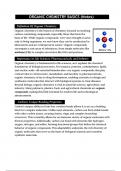ORGANIC CHEMISTRY BASICS (Notes) aaaaaaaa
Definition Of Organic Chemistryaa
Organic chemistry is the branch of chemistry focused on studying
carbon-containing compounds, especially those that form the
basis of life. While organic compounds were once thought to arise
only in living organisms, we now know they can be synthesized in
laboratories and are widespread in nature. Organic compounds
encompass a vast array of substances, from simple molecules like
methane (CH₄) to complex structures like DNA and proteins.
Importance in Life Sciences, Pharmaceuticals, and Industryaa
Organic chemistry is fundamental to life sciences, as it explains the chemical
foundations of biological processes. For instance, proteins, carbohydrates, lipids,
and nucleic acids—all essential biomolecules—are organic compounds that play
critical roles in cell structure, metabolism, and heredity. In pharmaceuticals,
organic chemistry is key to drug development, enabling scientists to design and
synthesize molecules that interact with biological systems to treat diseases.
Beyond biology, organic chemistry is vital in materials science, agriculture, and
industry. Many polymers, plastics, fuels, and agricultural chemicals are organic
compounds, making this field essential for modern life and technological
advancements.
aaCarbon’s Unique Bonding Propertiesaa
Carbon’s unique ability to form four covalent bonds allows it to act as a building
block for complex molecules. Unlike most elements, carbon can form stable bonds
with other carbon atoms, creating chains, rings, and complex branching
structures. This versatility allows for an immense variety of organic molecules with
diverse properties. Additionally, carbon can bond with elements like hydrogen,
oxygen, nitrogen, and sulfur, forming functional groups that define the chemical
behavior of organic compounds. This adaptability underpins the rich diversity of
organic molecules that serve as the basis of biological systems and countless
synthetic materials.
, Atomic Structure and Bondingaa
Review of Atomic Structure (Protons, Neutrons, Electrons)
Atoms are the fundamental building blocks of matter and are composed of three
primary subatomic particles: protons, neutrons, and electrons. Protons, which
carry a positive charge, and neutrons, which are neutral, reside in the atom's
nucleus, giving the nucleus most of its mass. Electrons, which are negatively
charged, orbit the nucleus in regions called electron shells. The number of protons
defines an element, while the arrangement of electrons in shells and orbitals
determines an atom’s chemical behavior.
Electronegativity and Bonding Types (Ionic, Covalent)aa
Electronegativity is a measure of an atom's tendency to attract electrons within a
bond. Elements with high electronegativity, such as oxygen and nitrogen, pull
electrons toward themselves, while elements with lower electronegativity, like
carbon and hydrogen, share electrons more equally. When atoms with differing
electronegativities interact, they can form ionic bonds, where electrons are
transferred (e.g., sodium chloride). However, in organic chemistry, covalent bonds,
where atoms share electrons, are more common. Covalent bonds allow carbon to
form stable bonds with other carbon atoms and with elements like hydrogen,
oxygen, and nitrogen.
Hybridization (sp, sp², sp³) in Organic Moleculesaa
Hybridization is a concept used to explain the specific geometries of molecular
bonds in organic chemistry. When carbon forms bonds, its atomic orbitals (s and p
orbitals) combine to create hybrid orbitals that match the observed shapes of
molecules. For example, in methane (CH₄), carbon undergoes sp³ hybridization,
forming a tetrahedral shape with bond angles of 109.5°. In ethene (C₂H₄), sp²
hybridization results in a planar shape with 120° bond angles. In ethyne (C₂H₂),
, sp hybridization creates a linear structure with 180° bond angles. Understanding
hybridization helps predict the geometry and reactivity of organic molecules,
which is essential for studying molecular interactions in organic chemistry.
Valence Shell Electron Pair Repulsion (VSEPR) Theoryaa
Valence Shell Electron Pair Repulsion (VSEPR) theory is a model used to predict
the three-dimensional shape of molecules based on the repulsion between
electron pairs around a central atom. According to VSEPR theory, electron pairs,
including both bonding pairs (shared between atoms) and lone pairs (non-bonding
pairs), arrange themselves as far apart as possible to minimize repulsive forces.
This arrangement of electron pairs ultimately determines the shape of the
molecule. VSEPR theory is particularly useful in organic chemistry, where
understanding molecular geometry helps explain the behavior, polarity, and
reactivity of organic compounds.
Common Molecular Shapes in Organic Moleculesaa
In organic chemistry, there are three common molecular shapes based on the
number of bonding regions around a central atom:
Linear: A linear shape occurs when there are two regions
of electron density around the central atom, as in carbon
dioxide (CO₂). The atoms are arranged in a straight line,
with a bond angle of 180°.
Trigonal Planar: This shape occurs when there are three regions
of electron density around the central atom, as in formaldehyde
(CH₂O). The atoms are arranged in a flat, triangular shape, with
bond angles of 120°.
Tetrahedral: A tetrahedral shape occurs with four regions of
electron density around the central atom, as seen in methane
(CH₄). The atoms are arranged in a three-dimensional shape with
bond angles of 109.5°.




